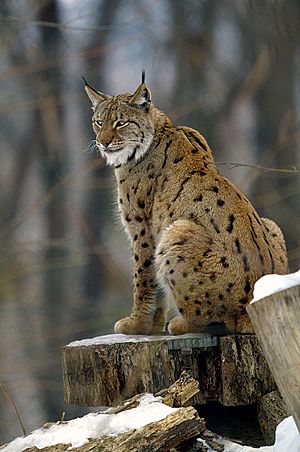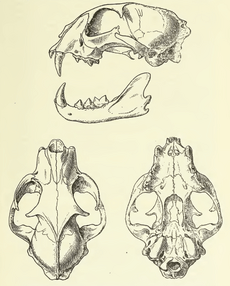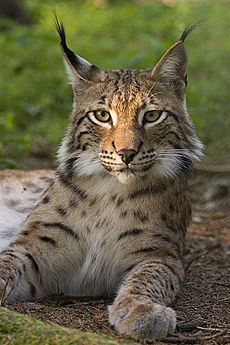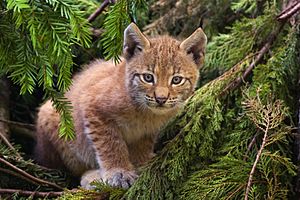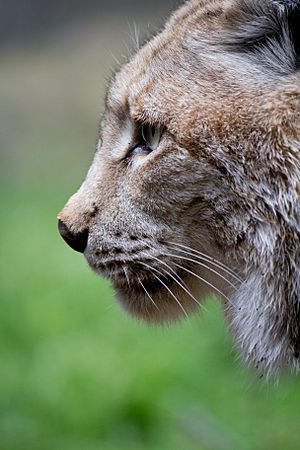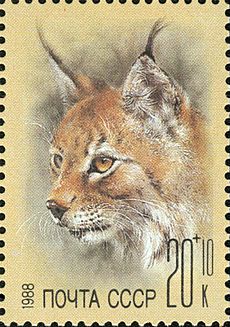Eurasian lynx facts for kids
The Eurasian lynx (Lynx lynx) is a medium-sized cat native to Europe (Including Finland, Sweden, Norway) and Asia. It is one of the largest predators in Europe and Asia. It is the largest of the lynxes with a length of 80–130 cm.
Contents
Prey
Lynx prey mostly on small to fairly large sized mammals and birds. Among prey for the species are hares, rabbits, marmots, squirrels, dormice, other rodents, grouse, red foxes, wild boar, foxes, chamois, moose, roe deer, red deer, reindeer and other ungulates.
Although taking on larger prey presents a risk to the animal, the bounty provided by killing them can outweigh the risks. The Eurasian lynx thus prefers fairly large ungulate prey, especially during winter when small prey is less abundant. They are the only Lynx species in which ungulates provide more of their diet than lagomorphs or rodents. Where common, roe deer are the preferred prey species for the lynx. Even where roe deer are quite uncommon, as in Sweden, the deer are still the favored prey species, though in summer smaller prey and occasional domestic sheep are eaten. In parts of Finland, introduced White-tailed deer are eaten mostly regularly. In some areas of Poland and Austria, red deer are the preferred prey and, in Switzerland, chamois are taken. They will also feed on carrion when it is available. Adult lynx require 1.1 to 2 kilograms (2.4 to 4.4 lb) of meat per day, and may take several days to fully consume some of their larger prey.
Distribution
Asia
Found in the Chinese provinces and Northern Pakistan.
Russia
Most Eurasian lynxes are in Russia.
Finland
In 2008, there were about 1905–2060 lynxes in Finland.
Sweden
In Sweden there are about 1,400.
Norway
In Norway there are between 409 to 439.
Physical characteristics
The Eurasian lynx is the largest lynx species, ranging in length from 80 to 130 cm (31 to 51 in) and standing 60–75 cm (24–30 in) at the shoulder. The tail measures 11 to 24.5 cm (4.3 to 9.6 in) in length. Males usually weigh from 18 to 30 kg (40 to 66 lb) and females weigh 8 to 21 kg (18 to 46 lb). Male lynxes from Siberia, where the species reaches the largest body size, can weigh up to 38 kg (84 lb) or reportedly even 45 kg (99 lb). It has powerful, relatively long legs, with large webbed and furred paws that act like snowshoes. It also possesses a short "bobbed" tail with an all-black tip, black tufts of hair on its ears, and a long grey-and-white ruff.
During the summer, the Eurasian lynx has a relatively short, reddish or brown coat, which tends to be more brightly coloured in animals living at the southern end of its range. In winter, however, this is replaced by a much thicker coat of silky fur that varies from silver-grey to greyish brown. The underparts of the animal, including the neck and chin, are white at all times of the year. The fur is almost always marked with black spots, although the number and pattern of these are highly variable. Some animals also possess dark brown stripes on the forehead and back. Although spots tend to be more numerous in animals from southern populations, Eurasian lynx with heavily spotted fur may exist close to others with plain fur.
Eurasian lynx make a range of vocalizations, but are generally silent outside of the breeding season. They have been observed to mew, hiss, growl, and purr, and, like domestic cats, will "chatter" at prey that is just out of reach. Mating calls are much louder, consisting of deep growls in the male, and loud "meow"-like sounds in the female.
Eurasian lynx are secretive, and because the sounds they make are very quiet and seldom heard, their presence in an area may go unnoticed for years. Remnants of prey or tracks on snow are usually observed long before the animal is seen.
Behaviour
Lynx prey largely on small to fairly large sized mammals and birds. Among the recorded prey items for the species are hares, rabbits, marmots, squirrels, dormice, other rodents, mustelids (such as martens), grouse, red foxes, wild boar, chamois, young moose, roe deer, red deer, reindeer and other ungulates. Although taking on larger prey presents a risk to the animal, the bounty provided by killing them can outweigh the risks. The Eurasian lynx thus prefers fairly large ungulate prey, especially during winter when small prey is less abundant. They are the only Lynx species in which ungulates provide a great portion of their diet in relation to lagomorphs or rodents. Where common, roe deer appear to be the preferred prey species for the lynx. Even where roe deer are quite uncommon, the deer are still quantitatively the favored prey species, though in summer smaller prey and occasional domestic sheep are eaten more regularly. In parts of Finland, introduced white-tailed deer are eaten mostly regularly. In some areas of Poland and Austria, red deer are the preferred prey and, in Switzerland, chamois may be locally favored. They will also feed on carrion when it is available. Adult lynx require 1.1 to 2 kilograms (2.4 to 4.4 lb) of meat per day, and may take several days to fully consume some of their larger prey.
The main method of hunting is stalking, sneaking and jumping on prey, although they are also ambush predators when conditions are suitable. In winter certain snow conditions make this harder and the animal may be forced to switch to larger prey. Eurasian lynx hunt using both vision and hearing, and often climb onto high rocks or fallen trees to scan the surrounding area. A very powerful predator, these lynxes have successfully killed adult deer weighing to at least 150 kg (330 lb).
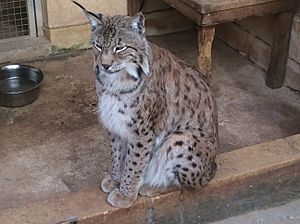
The Eurasian lynx inhabits rugged forested country providing plenty of hideouts and stalking opportunities. Depending on the locality, this may include forest-steppe, boreal forest, and montane forest. In the more mountainous parts of their range, Eurasian lynx will descend into the lowlands in winter, following their prey, and avoiding the deepest snows. They tend to be less common where wolves are abundant, and wolves have been reported to attack and even eat lynx. In Russian forests, the most important predators of the Eurasian lynx are the grey wolf and the wolverine. Wolves kill and eat lynxes that fail to escape into trees. Lynx populations decrease when wolves appear in a region and are likely to take smaller prey where wolves are active. Wolverines are perhaps the most dogged of competitors for kills, often stealing lynx kills. Lynxes tend to actively avoid encounters with wolverines, but may sometimes fight them if defending kittens. In one case in Sweden, with another known instance of predation by an adult wolverine on an adult lynx was seen in the Pechora River area. There are no known instances of lynx preying on a wolverine. Sometimes, Siberian tigers have also preyed on lynxes, as evidenced by examination of tiger stomach contents. Lynx compete for food with the predators described above, and also with the red fox, eagle owls, golden eagles, wild boar (which scavenge from lynx kills), and in the southern part of its range, the snow leopard and leopard as well.
Although they may hunt during the day when food is scarce, the Eurasian lynx is mainly nocturnal or crepuscular, and spends the day sleeping in dense thickets or other places of concealment. It lives solitarily as an adult.
The hunting area of Eurasian lynx can be anything from 20 to 450 km2 (8 to 174 sq mi), depending on the local availability of prey. Males tend to hunt over much larger areas than females, which tend to occupy exclusive, rather than overlapping, hunting ranges. The Eurasian lynx can travel up to 20 km (12 mi) during one night, although about half this distance is more typical. They patrol regularly throughout all parts of their hunting range, using scent marks to indicate their presence to other individuals. As with other cats, the scent marks may consist of faeces, urine, or scrape marks, with the former often being left in prominent locations along the boundary of the hunting territory.
Life cycle
The mating season for Eurasian lynx lasts from January to April. The female typically comes into oestrus only once during this period, lasting from four to seven days, but if the first litter is lost, a second period of oestrus is common. Unlike the closely related Canada lynx, the Eurasian species does not appear to be able to control its reproductive behaviour based on prey availability. This may be because, feeding on a larger range of prey than the Canada lynx, rarity of suitable prey is a less common occurrence.
Pregnant females construct dens in secluded locations, often protected by overhanging branches or tree roots. The den may be lined with feathers, deer hair, and dry grass to provide bedding for the young. Gestation lasts from 67 to 74 days, and results in the birth of from one to four kittens. At birth, Eurasian lynx kittens weigh 240 to 430 grams (8.5 to 15.2 oz) and are blind and helpless. They initially have plain, greyish-brown fur, attaining the full adult colouration around eleven weeks of age. The eyes open after ten to twelve days. The kittens begin to take solid food at six to seven weeks, when they begin to leave the den, but are not fully weaned for five or six months.
The den is abandoned two to three months after the kittens are born, but the young typically remain with their mother until they are around ten months of age (the start of the next breeding season). Eurasian lynx reach sexual maturity at two or three years, and have lived for twenty one years in captivity.
Range and status
Russia
As of 2013, the Russian lynx population is estimated as comprising 22,510 individuals and is considered abundant and stable in some regions.
Asia
Although the Eurasian lynx is not found in Japan, fossils of Eurasian or closely related species from the late Pleistocene era and onward have been excavated from various locations of Japanese archipelago, indicating its extinction there was caused by human activities during the Jōmon period.
- Central Asia: The Eurasian lynx is native to the Chinese provinces of Xinjiang, Gansu, Qinghai, Sichuan, and Shaanxi, as well as to northern slopes of Iran's Alborz Mountains, Mongolia, Kazakhstan, Uzbekistan, Turkmenistan, Kyrgyzstan, Tajikistan and Afghanistan.
- India: Kashmir's Ladakh area, Himachal Pradesh and most other Himalayan states.
- Nepal: Most of northern areas of country.
- Pakistan: The Northern Areas (Gilgit–Baltistan), adjoining areas of Khyber Pakhtunkhwa, FATA
- Turkey: until 2014, lynx population density was estimated in only one protected area, the Ciglikara Nature Reserve located in the Taurus Mountains where 15 individuals were identified. Various government bodies are responsible for wildlife in Turkey and before 1990, hunting of Lynx was uncontrolled. Since then hunting has been restricted and there are 83 game conservation and breeding areas where hunting is prohibited. This has had a positive effect on their conservation in Turkey. Research carried out in Kars have discovered a new breeding population in Sarıkamış. However, threats from legal and illegal logging as well as illegal poaching exists.
Europe
The Eurasian lynx was once quite common in all of Europe. By the middle of the 19th century, it had become extirpated in most countries of Central and Western Europe. There have been successful attempts to reintroduce this lynx to forests.
Status of the Eurasian lynx in various European countries and regions:
- Carpathian Mountains: About 2,800 lynx live in this mountain range in the Czech Republic, Poland, Romania, Slovakia, Bosnia and Herzegovina, and Serbia. It is the largest contiguous Eurasian Lynx population west of the Russian border.
- Romania: over 2000 lynx live in Romania, including most of the Carpathian population. However, some experts consider these official population numbers to be overestimated. Limited hunting is permitted but the population is stable.

- Balkan peninsula: The Balkan lynx subspecies is found in Croatia, Montenegro, Albania, Kosovo, Republic of Macedonia, Serbia, Bulgaria and possibly Greece. They can be found in remote mountainous regions of the Balkans, with the largest numbers in remote hills of western Macedonia, eastern Albania and northern Albania. The Balkan Lynx is considered a national symbol of Macedonia, and it is depicted on the reverse of the Macedonian 5 denars coin, issued in 1993. The name of Lynkestis, a Macedonian tribe, is translated as "Land of the Lynx". It has been on the brink of extinction for nearly a century. Numbers are estimated to be around one hundred, and the decline is due to illegal poaching. The animal was declared extinct in Bulgaria in 1985, but sightings continued well into the 1990s. In 2006 an audio recording of a lynx mating call was made in the Strandzha mountain range in the southeast. Two years later an ear-marked individual was accidentally shot near Belogradchik in the northwest, and a few months later a mounted trap camera caught a glimpse of another individual. Further camera sightings followed in Osogovo as well as Strandzha, confirming that the animal has returned to the country. A thorough examination on the subject is yet to be made available.
- Britain: It was thought that the lynx had died out in Britain either about 10,000 years ago, after the ice had retreated, or about 4,000 years ago, during a cooler and wetter climate change. However, carbon dating of lynx bones from caves in Sutherland in the Scottish Highlands and in Craven in North Yorkshire show they still lived in Britain between 80 and 425 AD, with cultural sources suggesting a survival until the medieval period. Old names for the species in the languages of Britain include Lugh (Gaelic), Llew (Welsh) and Lox (Old English). There is interest in reintroducing the lynx to Britain in order to return some natural state of control to deer populations, which have no natural predators left in Britain. A study of the biological feasibility of reintroducing Eurasian lynx to Scotland indicates there is sufficiently abundant prey and well-connected habitat to support a viable population of over 400 animals. Interest in reintroducing the species was further bolstered in 2016 in relation to a successful breeding programme for the Iberian lynx in Spain. Plans have also been submitted by the Lynx UK Trust to Natural England to introduce the lynx to Kielder Forest in Northumberland. A proposal by the same organisation to reintroduce the lynx to Argyll and Inverness-shire is undergoing public consultation.
- Czech Republic: In Bohemia, the lynx was exterminated in the 19th century (1830–1890) and in Moravia probably at the turn of the 20th century. After 1945, migration from Slovakia created a small and unstable population in Moravia. In the 1980s, almost 20 specimens were imported from Slovakia and reintroduced in the Šumava area. In early 2006, the population of lynx in the Czech Republic was estimated at 65–105 individuals. Hunting is prohibited, but the lynx is often threatened by poachers.
- Dinaric Alps and Julian Alps: Slovenia, Croatia, and Bosnia and Herzegovina are home to approx. 130–200 lynx. The Eurasian lynx had been considered extinct in these countries since the beginning of the 20th century. However, a successful reintroduction project was carried out in Slovenia in 1973, when three female and three male lynx from Slovakia were released in the Kočevski Rog forest. Today, lynx is present in the Dinaric forests of the south and southeastern part of Slovenia and in the Croatian regions of Gorski kotar and Velebit, spanning the Dinaric Alps and over the Dinara Mountain into western Bosnia and Herzegovina. The lynx has been also spotted in the Julian Alps and elsewhere in western Slovenia, but the A1 motorway presents a significant hindrance to the development of the population there. Croatia's Plitvice Lakes National Park is home to several pairs of the lynx. In the three countries, the Eurasian lynx is listed as an endangered species and protected by law. Realistic population estimates are 40 lynx in Slovenia, 40–60 in Croatia, and more than 50 in Bosnia and Herzegovina. The Croatian massif Risnjak in Risnjak National Park probably got its name from the Croatian word for the lynx, ris.
- Estonia: There are 900 individuals in Estonia according to a 2001 estimate. Although 180 lynx were legally hunted in Estonia in 2010, the country still has the highest known density of the species in Europe.
- Fennoscandia: Fennoscandian lynx were close to extinction in the 1930s–1950s but increased again thanks to protection. In the meantime protective hunting for lynx has been legalized again. The numbers are still on a slow increase. Lynx is the only non-domestic feline in Scandinavia.
- Finland: about 2200–2300 individuals, according to a 2009 estimate. Lynx population in Finland have been increasing every year since 1991, and is estimated to be nowadays larger than ever before. Limited hunting is permitted. In 2009 the Finnish Ministry of Agriculture and Forestry gave a permit for hunting of 340 lynx individuals.
- Norway: The Eurasian Lynx is found in stable populations throughout Norway except for the southwestern counties, where they are only found sporadically. The national goal of 65 lynx births was reached in 2007, with 69 to 74 registered lynx born. The population was estimated at 409–439 specimens.
- Sweden: Sweden had an estimated population of about 1400 lynx in 2006 and 1250 in 2011. The hunt is controlled by government agencies. Hunters who wish to hunt for lynx must register for the so-called "protective hunt," which takes place in March. The hunt may only take place if the population has an annual increase of 300 animals. The government has allowed the requirement to fall to an increase of 250 lynx under "certain circumstances" and still permit the hunt. Even though the goal is rarely met, the hunt is always approved. This has led to a steady decrease of the number of lynx in Sweden and protests from larger non-governmental organisations such as the Swedish Society for Nature Conservation. Only a few animals are allowed to be shot in each region, depending on the size of the local lynx population and/or how the reindeer herding is affected. Every shot animal and shooting location is controlled by the County Administration, and the carcass is sent away for analysis to the National Veterinary Institute. The hunter may keep the skin, if a microchip or transponder is attached by the local police authority. The skull of the shot animal can be sent back to the hunter for a fee of about €70. No more than 75 animals in 20 regions were permitted to be shot in 2007, an increase from 51 in 2006 (always about 5% of the population). In 2006 there were 41 lynx killed outside of hunting, 31 of which were killed in traffic accidents.
- France: The lynx was exterminated in the French Alps in the early 20th century. Following reintroduction of lynx in Switzerland in the 1970s, lynx were recorded again in the French Alps and Jura from the late 1970s onwards.
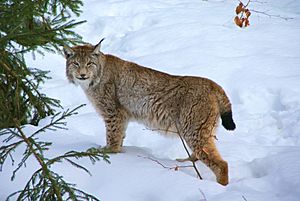
- Germany: The Eurasian Lynx was exterminated in Germany in 1850. It was reintroduced to the Bavarian Forest and the Harz in the 1990s; other areas were populated by lynx immigrating from neighboring France and the Czech Republic. In 2002 the first birth of wild lynx on German territory was announced, following a litter from a pair of lynx in the Harz National Park. Small populations exist also in Saxon Switzerland, Palatinate Forest, and Fichtelgebirge.
- Latvia: According to a 2005 estimate, about 700 animals inhabit areas in Courland and Vidzeme.
- Lithuania: Population is estimated at 80–100 animals.
- Netherlands: The lynx has been extinct in the Netherlands since the Middle Ages. Although there were some sightings, they probably stem from captive-bred lynx which have escaped or were released to the wild, or may be lynx moving in from Germany, since several of the sightings reported during the 1980s and 1990s were around the Reichswald area.
- Belgium: The lynx was extinct for about 300 years, but started to recolonize the eastern part of the country in the first decade of the 21st century (around Vielsalm and Voeren). These animals are probably individuals from the lynx populations in the Eifel region of Germany or the Vosges region of France, or possibly also illegal introductions by hunters.
- Poland: The Mammal Research Institute of the Polish Academy of Sciences has information about "at least 128 lynx", observed in 2006/2007. The report suggests that the number is underestimated.
- Slovakia: The lynx is native to forested areas in Central and East Slovakia. The lynx in Slovakia live mainly in mixed forests at altitudes from 800 to 1000 m. The feline can also be found in many national parks of Slovakia and other protected areas.
- Switzerland: The lynx became extinct here in 1915, but was reintroduced in the 1970s. As of 2014, the overall lynx population in Switzerland was estimated to be around 173 (163-182) independent (subadult and adult) individuals. Swiss lynx also migrated to Austria, where they had also been exterminated. A higher proportion are killed by human causes than by infectious diseases.
- Italy: The Lynx was considered extinct since the early 20th century but over the past 30 years a partial recolonization of the Alps, from the Swiss and Slovenian populations, is occurring. Claims in 2009 of the existence of a very small population in central Italy proved to be unsubstantiated.
- Ukraine: The lynx is native to forested areas of the country. Before the 19th century it was common also in the Forest steppe zone. Nowadays, the most significant populations remain in the Carpathian mountains and across the forests of Polesia. The population is estimated as 80–90 animals for the Polesia region and 350–400 for the forests of the Carpathians.
Images for kids
See also
 In Spanish: Lince boreal para niños
In Spanish: Lince boreal para niños


